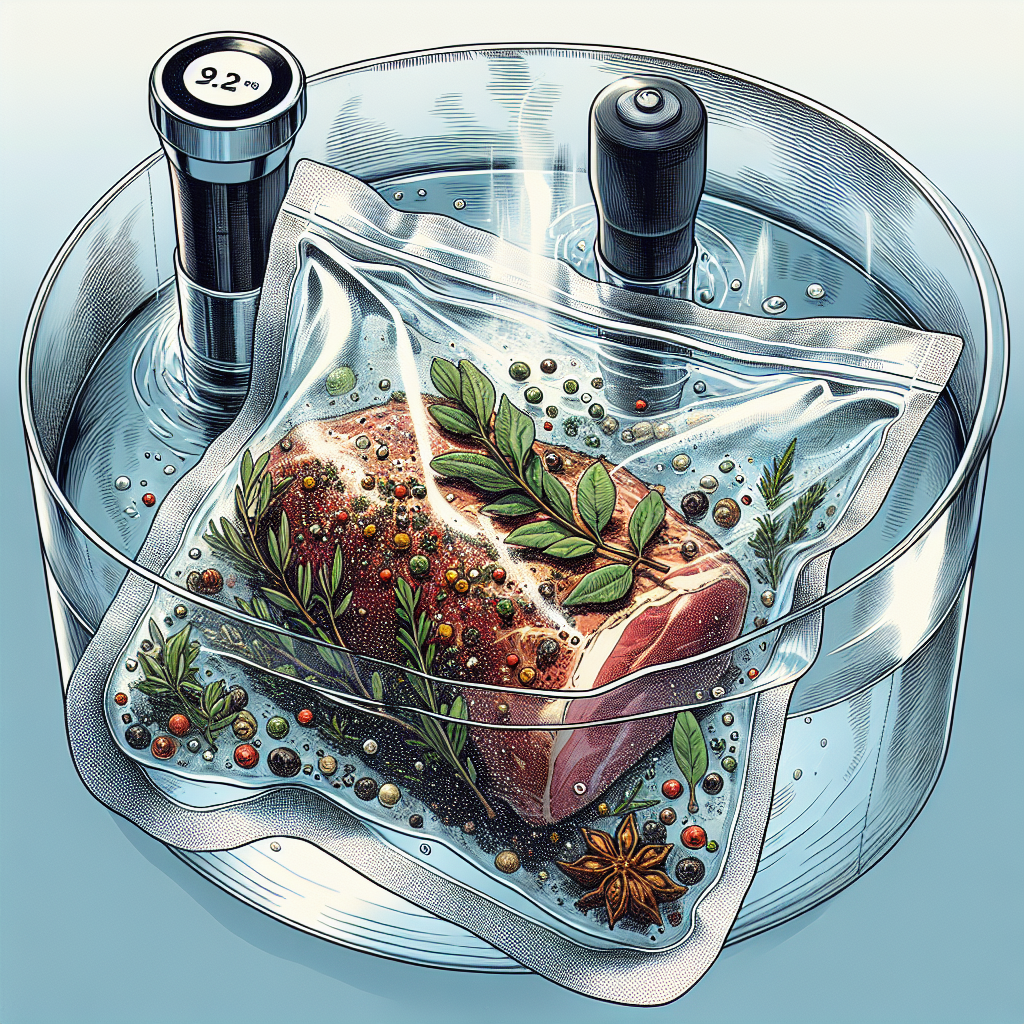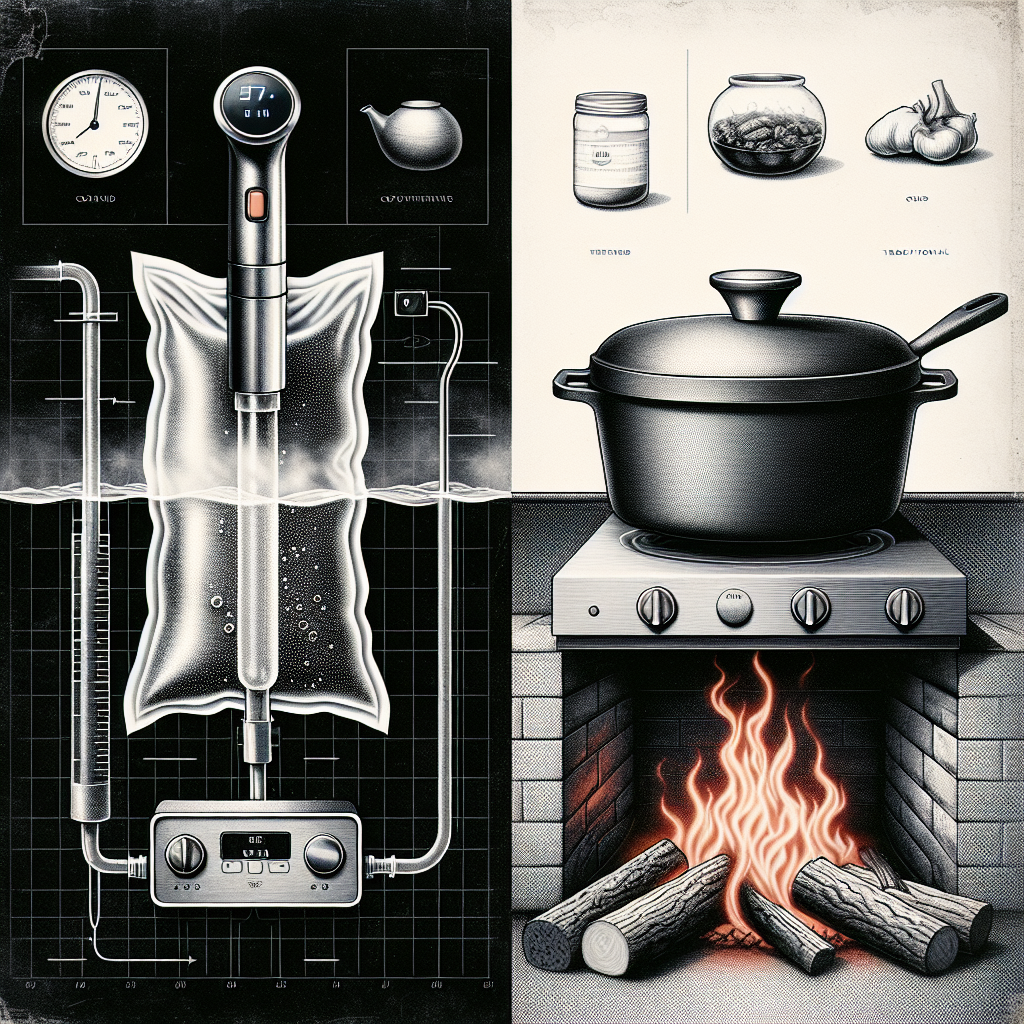
Imagine being able to cook your meals to perfection every single time, with flavors so rich and textures so tender that they leave you craving for more. Sous vide cooking, a method that is gaining popularity in kitchens worldwide, offers just that. In this article, we will explore how sous vide cooking compares to traditional cooking methods, and discover the unique benefits it brings to your culinary adventures. Get ready to elevate your cooking game and indulge in mouthwatering dishes like never before!
Overview of Sous Vide Cooking
Sous vide cooking is a culinary technique that involves cooking food in a precise temperature-controlled water bath. This method utilizes vacuum-sealed bags, allowing the food to slowly cook at a consistent temperature, resulting in perfectly cooked meals with enhanced flavor and texture. Unlike traditional cooking methods that rely on direct heat, sous vide provides a more controlled and even cooking process, leading to reliable and delicious results.
Definition of Sous Vide Cooking
Sous vide, which means “under vacuum” in French, refers to the process of vacuum-sealing food in a bag and cooking it at a precisely controlled temperature in a water bath. By utilizing this technique, food is cooked evenly and retains its natural juices and flavors, resulting in delectable and tender dishes.
History of Sous Vide Cooking
The concept of sous vide cooking can be traced back to the late 18th century when Sir Benjamin Thompson, an American-born inventor, proposed the idea of low-temperature cooking. However, it wasn’t until the mid-1960s that sous vide gained popularity thanks to Georges Pralus and Bruno Goussault, who further developed and refined the method. Today, sous vide cooking has become a widely recognized technique used by both professional chefs and home cooks.
Explanation of Traditional Cooking Methods
Traditional cooking methods, such as grilling, baking, frying, and boiling, involve applying direct heat to food. While these methods have been used for centuries and are deeply ingrained in our culinary practices, they often lack the precision and consistency offered by sous vide cooking. The variations in temperature and cooking times associated with traditional methods can lead to unevenly cooked food, resulting in inconsistent flavor, texture, and tenderness.
Temperature Control
Precise Temperature Control in Sous Vide Cooking
One of the primary benefits of sous vide cooking is the ability to maintain precise temperature control. By setting the water bath to the desired temperature, you can ensure that your food is cooked to perfection. The use of immersion circulators or sous vide machines allows for accurate temperature control within a fraction of a degree, giving you the confidence to achieve consistent results every time.
Inconsistent Temperature Control in Traditional Cooking Methods
Traditional cooking methods often struggle to maintain a consistent temperature throughout the cooking process. Heat sources like stovetops, ovens, and grills can fluctuate, leading to uneven cooking. For example, when grilling a steak, the exterior may become overcooked while the interior remains undercooked. These inconsistencies can be frustrating and result in less-than-desirable outcomes.
Cooking Time
Extended Cooking Time in Sous Vide Cooking
Sous vide cooking typically requires longer cooking times compared to traditional methods. However, this extended cooking time is often a trade-off for the outstanding results it offers. By cooking food at a lower temperature over an extended period, the proteins break down gradually, resulting in incredibly tender and flavorful meals. While this may not be suitable for time-sensitive situations, it is perfect for those who appreciate the incredible taste and tenderness that can only be achieved through patience and precision.
Variable Cooking Time in Traditional Cooking Methods
Traditional cooking methods often require precise timing to achieve the desired doneness. Unfortunately, variations in heat sources and food thickness can make it difficult to determine the exact cooking time. For example, when roasting a chicken, you may find that the breast becomes dry and overcooked while the darker meat remains undercooked. These inconsistencies in cooking time can make it challenging to consistently achieve perfectly cooked dishes.
Flavor and Texture
Enhanced Flavor Retention in Sous Vide Cooking
Sous vide cooking excels in retaining the natural flavors of the ingredients. By sealing the food in a vacuum bag, the aromas and flavors remain enclosed, resulting in a concentrated and more intense taste. Additionally, the slow cooking process allows the flavors to infuse deeply into the food, resulting in dishes that are bursting with succulent flavors.
Varied Flavor and Texture in Traditional Cooking Methods
Traditional cooking methods often produce varied flavors and textures due to the inconsistent heat distribution and cooking times. For example, searing a steak on high heat can result in a crispy exterior but may leave the inside undercooked. The variations in flavor and texture can be exciting for those who enjoy the unpredictability, but may sometimes lead to disappointing outcomes.

Tenderness and Moisture
Consistent Tenderness and Moisture in Sous Vide Cooking
The precision and slow cooking process of sous vide cooking result in consistently tender and juicy meals. By cooking food at a precise temperature for an extended period, the proteins break down gradually, leading to incredibly tender and moist dishes. Whether it’s a perfectly cooked steak or a succulent piece of fish, sous vide cooking ensures that every bite is filled with tenderness and moisture.
Potential Loss of Tenderness and Moisture in Traditional Cooking Methods
Traditional cooking methods, such as grilling or pan-frying, can easily lead to overcooking or drying out the food. The higher temperatures and direct heat can cause the proteins to shrink and lose moisture rapidly, resulting in less tender and dry dishes. Achieving consistent tenderness and moisture can be challenging, often requiring careful monitoring and experience.
Versatility
Wide Range of Foods and Ingredients for Sous Vide Cooking
Sous vide cooking offers an extensive range of possibilities when it comes to the types of foods and ingredients that can be prepared. From vegetables and meats to delicate seafood and even desserts, sous vide cooking allows you to explore various culinary creations. The precise temperature control and extended cooking times are particularly beneficial for tougher cuts of meat, which can be transformed into incredibly tender and flavorful dishes.
Limited Versatility of Traditional Cooking Methods
Traditional cooking methods, while versatile in their own right, may not have the same level of flexibility when it comes to certain ingredients and dishes. Delicate foods like fish can easily overcook and lose their tenderness when exposed to high heat, while tougher cuts of meat may require additional time and effort to achieve the desired level of tenderness. Sous vide cooking provides a level of versatility that traditional methods often struggle to match.
Convenience and Flexibility
Ease of Use and Convenience of Sous Vide Cooking
Sous vide cooking offers a level of convenience and ease of use that is hard to match with traditional methods. Once you have sealed the food in a vacuum bag and set the water bath to the desired temperature, you can walk away and let the sous vide machine do its magic. There is no need for constant monitoring or adjusting heat sources, giving you the freedom to focus on other tasks or simply relax while your meal cooks to perfection.
Flexibility and Adaptability of Traditional Cooking Methods
Traditional cooking methods provide a certain level of flexibility and adaptability, allowing for spontaneous cooking and experimentation. Whether you prefer to whip up a quick stir-fry or throw together a last-minute soup, traditional methods can accommodate a wide range of cooking styles and techniques. The ability to adjust temperatures and cooking times on the fly can be appealing for those who enjoy the creativity and spontaneity in the kitchen.
Energy Efficiency
Lower Energy Consumption in Sous Vide Cooking
Sous vide cooking is known for its energy efficiency compared to traditional methods. The use of precise temperature control and longer cooking times allows for lower heat requirements. Unlike the high temperatures and extended preheating often necessary in traditional methods, sous vide cooking uses less energy, making it an eco-friendly option. Additionally, the lack of direct heat also reduces the risk of accidentally burning food, further conserving energy.
Higher Energy Consumption in Traditional Cooking Methods
Traditional cooking methods often require more significant energy consumption due to the direct heat sources involved. Preheating ovens, stovetops, or grills and continuously adjusting heat levels can lead to higher energy bills. The quick and intense bursts of heat required for traditional methods explain this increased energy consumption. While traditional cooking methods may have their advantages, sous vide cooking offers a more energy-efficient alternative.
Presentation and Aesthetics
Uniform Presentation in Sous Vide Cooking
Sous vide cooking can create visually stunning dishes, thanks to its ability to provide uniform cooking throughout the food. The slow and controlled cooking process ensures that every part of the ingredient is evenly cooked, resulting in a consistent appearance. Whether it’s a perfectly pink medium-rare steak or vibrant green asparagus, the visual appeal of sous vide cooking adds a professional touch to your meals.
Varied Presentation and Aesthetics in Traditional Cooking Methods
Traditional cooking methods often produce dishes with varying degrees of doneness, resulting in a less uniform appearance. The appearance of food cooked using traditional methods can have a rustic charm and appeal to those who enjoy the natural variations that come with it. However, if consistent presentation and aesthetics are important to you, sous vide cooking provides a more reliable and visually pleasing outcome.
Health and Safety
Food Safety Considerations in Sous Vide Cooking
Sous vide cooking has specific food safety considerations that need to be addressed. While the precise temperature control minimizes the risk of bacterial growth, it is crucial to ensure that the food reaches the appropriate internal temperature to destroy any potential pathogens. Proper vacuum sealing techniques and cooking times outlined in guidelines and recipes are essential for maintaining food safety when using this method.
Food Safety and Health Benefits of Traditional Cooking Methods
Traditional cooking methods have their own food safety considerations and health benefits. The high heat involved in methods such as grilling or roasting can effectively kill bacteria, and the intense heat can also result in the formation of flavorful crusts and charred edges. Additionally, traditional cooking methods promote the development of rich flavors through the Maillard reaction, a chemical reaction that occurs at high temperatures, enhancing taste and creating new complex flavors.
In conclusion, sous vide cooking offers significant advantages over traditional cooking methods. With precise temperature control, extended cooking times, enhanced flavor retention, consistent tenderness and moisture, versatility, convenience, energy efficiency, uniform presentation, and the importance of food safety, sous vide cooking stands as a reliable and innovative culinary technique. While traditional cooking methods have their charm and merits, the meticulousness and consistent results achieved through sous vide cooking make it a valuable addition to any kitchen. So, why not give sous vide cooking a try and elevate your culinary creations to new heights of flavor and tenderness?





